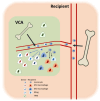Unraveling the Roles of Macrophages in Vascularized Composite Allotransplantation
- PMID: 40564144
- PMCID: PMC12189788
- DOI: 10.3390/biomedicines13061425
Unraveling the Roles of Macrophages in Vascularized Composite Allotransplantation
Abstract
The phenotypic heterogeneity and functional diversity of macrophages have been increasingly appreciated, particularly regarding their roles as innate immune cells in shaping transplantation outcomes. However, their functions in vascularized composite allotransplantation (VCA) remain underexplored. In this review, we first describe the development of macrophages and the heterogeneity of macrophage differentiation, then present current insights into macrophages' involvement across key stages of VCA, including ischemia-reperfusion injury at the peri-transplantation stage, and the outcomes following transplantation, including acute rejection, chronic rejection, and development of transplantation tolerance. The existing evidence supports that macrophages significantly influence both short- and long-term VCA graft survival. The presence of vascularized bone marrow within some VCA grafts further suggests the involvement of donor bone marrow-derived macrophage population and adds another layer of complexity to immune dynamics. Collectively, current understanding highlights the macrophage as a promising target for therapeutic intervention and warrants continued investigation into their diverse functions and potential for improving VCA outcomes.
Keywords: M1 macrophage; M2 macrophage; ischemia–reperfusion injury; macrophage; regulatory macrophage; transplantation rejection; transplantation tolerance; vascularized composite allotransplantation.
Conflict of interest statement
The authors declare no conflicts of interest. The funder had no role in the design of the study; in the collection, analyses, or interpretation of data; in the writing of the manuscript; or in the decision to publish the results.
Figures


Similar articles
-
Does Augmenting Irradiated Autografts With Free Vascularized Fibula Graft in Patients With Bone Loss From a Malignant Tumor Achieve Union, Function, and Complication Rate Comparably to Patients Without Bone Loss and Augmentation When Reconstructing Intercalary Resections in the Lower Extremity?Clin Orthop Relat Res. 2025 Jun 26. doi: 10.1097/CORR.0000000000003599. Online ahead of print. Clin Orthop Relat Res. 2025. PMID: 40569278
-
Challenges and opportunities in vascularized composite allotransplantation of joints: a systematic literature review.Front Immunol. 2023 May 19;14:1179195. doi: 10.3389/fimmu.2023.1179195. eCollection 2023. Front Immunol. 2023. PMID: 37275912 Free PMC article.
-
The future role of mitochondrial drugs in vascularized composite allotransplantation: A short review.Cell Transplant. 2025 Jan-Dec;34:9636897251347749. doi: 10.1177/09636897251347749. Epub 2025 Aug 11. Cell Transplant. 2025. PMID: 40790802 Free PMC article. Review.
-
A Systematic Review of the Reported Complications Related to Facial and Upper Extremity Vascularized Composite Allotransplantation.J Surg Res. 2023 Jan;281:164-175. doi: 10.1016/j.jss.2022.08.023. Epub 2022 Sep 24. J Surg Res. 2023. PMID: 36162189
-
Pretreatments of Ex Vivo Vascularized Composite Allografts: A Scoping Review.Ann Plast Surg. 2025 Jun 4. doi: 10.1097/SAP.0000000000004420. Online ahead of print. Ann Plast Surg. 2025. PMID: 40532232
References
-
- Priceman S.J., Sung J.L., Shaposhnik Z., Burton J.B., Torres-Collado A.X., Moughon D.L., Johnson M., Lusis A.J., Cohen D.A., Iruela-Arispe M.L., et al. Targeting distinct tumor-infiltrating myeloid cells by inhibiting CSF-1 receptor: Combating tumor evasion of antiangiogenic therapy. Blood. 2010;115:1461–1471. doi: 10.1182/blood-2009-08-237412. - DOI - PMC - PubMed
-
- Fischer S., Lian C.G., Kueckelhaus M., Strom T.B., Edelman E.R., Clark R.A., Murphy G.F., Chandraker A.K., Riella L.V., Tullius S.G., et al. Acute rejection in vascularized composite allotransplantation. Curr. Opin. Organ Transplant. 2014;19:531–544. doi: 10.1097/MOT.0000000000000140. - DOI - PubMed
Publication types
Grants and funding
LinkOut - more resources
Full Text Sources

